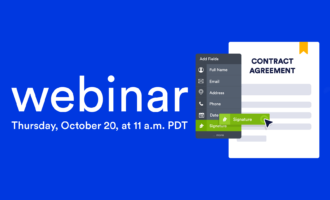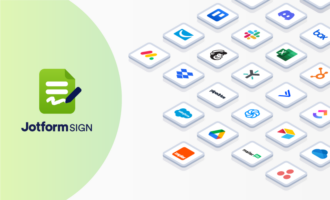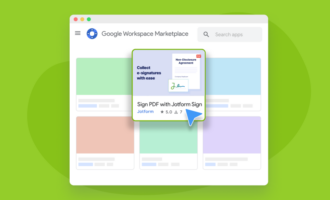From saving time to boosting engagement, automation features are a no-brainer for your company and your customers.
Automation is everywhere, from your grocery store checkout counter to those confirmation emails when signing up for yet another newsletter. Automation is anytime technology does the work for you, or, as IBM puts it, “where human input is minimized.”
Unfortunately, automation gets a bad rap sometimes for its perceived role in taking jobs from human beings. But, according to a study by MIT and Boston University, any potentially negative impact on the job market can be offset by new tasks as “all technologies create productivity effects that contribute to labor demand.” The World Economic Forum likewise estimated that by 2025, digital technologies will create at least 12 million more jobs than they eliminate. Bottom line: automation is a positive force, for both companies and their customers.
When I launched my company Jotform over 16 years ago, my goal was to automate a relatively minor but ubiquitous part of our users’ lives — online forms, which are a way of automating communication. Since then, we’ve expanded to other products, including PDFs, spreadsheets, and most recently, Jotform Sign, a user-friendly tool that enables you to create legally binding documents and collect e-signatures. I can attest to the power of automation not only because we have over 15 million users, but also because our teams use our automation features every single day.
In fact, automation tools are so powerful that when you offer them to users, they tend to sell themselves. Here, a closer look at why.
1. Automation saves time
The New York Times recently reported that Starbucks has seen surging sales from younger customers, who are ordering “elaborate, cold, customized coffees, like venti caramel crunch frappuccinos.” These cold drinks now make up a whopping 70 percent of Starbucks’ revenues.
The problem? Starbucks employees have been struggling to whip up the cold beverages fast enough.
To help employees manage the inflow of drink orders, Starbucks is implementing an automated system, which will potentially reduce preparation time by more than half. But the company said it has no plan to replace baristas (to the contrary, they’re opening thousands of new locations). They simply want to speed up their processes, and minimize the time you wait for that Iced Pumpkin Spice Latte.
Similarly, my team continues to grow and we continue to implement more automated systems. For example, we use the Jotform Approvals tool to get quick feedback from large groups of employees. And I’m sure we’ll start using the new Jotform Sign feature as soon as it’s live (today). For starters, it’s fast — you can create, share, and e-sign documents in minutes. It’s intuitive — you can use our drag-and-drop builder to create signable documents. It’s also easy to share — you can collect signatures using a link, a signature document, or by embedding your signature document in a website.
What’s more, Jotform Sign is compatible with our other products. You can use our PDF Editor to build a PDF, then convert it into a legally binding, signable document to collect e-signatures online. And that’s another thing — adding automation features to products that your customers are already using is a built-in growth machine. You don’t have to worry about bringing traffic to the product (often the biggest battle for business owners) because the users are already there.
Automation saves precious time — and doesn’t mean anyone is being replaced. In fact, it might lead you to be able to grow your company even faster. It goes without saying, leaders should be proactive to train employees on new technologies entered into work systems.
2. Automation increases engagement and innovation
A study commissioned by Automation Anywhere found that workers spend more than 40 percent of their day on manual digital administrative processes. Imagine how much time you could capture if you automated those tasks instead — about 3.2 hours of each 8-hour workday.
What’s more, by enabling employees to automate tasks, they can spend more time on other, more fulfilling work, which in turn, boosts engagement. And now, in the midst of the ongoing Great Resignation, engagement has never been more important. Consider, for example, the study that estimated that in August 2021, 55% of workers intended to look for a new job in the next year.
Importantly, automation isn’t just a way for keeping your employees from quitting, but encouraging employees to automate can even foster their input on how to do so, creating bottom-up solutions.
Take the “digital kaizen approach”: as Harvard Business Review explained, it’s basically an in-house platform where employees can submit ideas and turn those ideas into a working prototype, ready to be tested. The accounting firm PwC utilized this approach and the results speak for themselves: “PwC citizen developers, as platform contributors are called, have created over 7,000 automation on their digital kaizen platform. In the U.S. branch alone, more than 95% of partners and staff (about 55,000 people) are active on the platform.”
When you create an atmosphere of automation, people will look for ways to get things done faster.
3. Automation can boost sales
And finally, automation is an easy way to get more leads and, ultimately, sales.
Zapier is a tool that many of our Jotform team members use. Essentially, it enables all of your apps to communicate with each other. On their website, they offer a great example of how their automation services can directly augment your sales.
Say your company receives a lead through Facebook. Using Zapier, you can make it so this lead will trigger an email to be sent (called a “Zap”). A Zap can include up to 100 actions or an entire workflow. So while this workflow is happening, unbeknownst to you, you can focus on other things. And what’s more, the quicker you can reply to potential customers, the better. As reported by Forbes, research from Velocify found that 391% of leads buy from the company that responds to inquiries within the first minute.
Automating your initial response will help convert a lead into a customer.
Automation tools make your company’s and customers’ work a whole lot easier. Incorporating them into your workflows is almost intuitive. Offering them to your existing customers is a no-brainer. Like great coffee or quick checkout lines, they’re so practical that they almost sell themselves.












Send Comment: